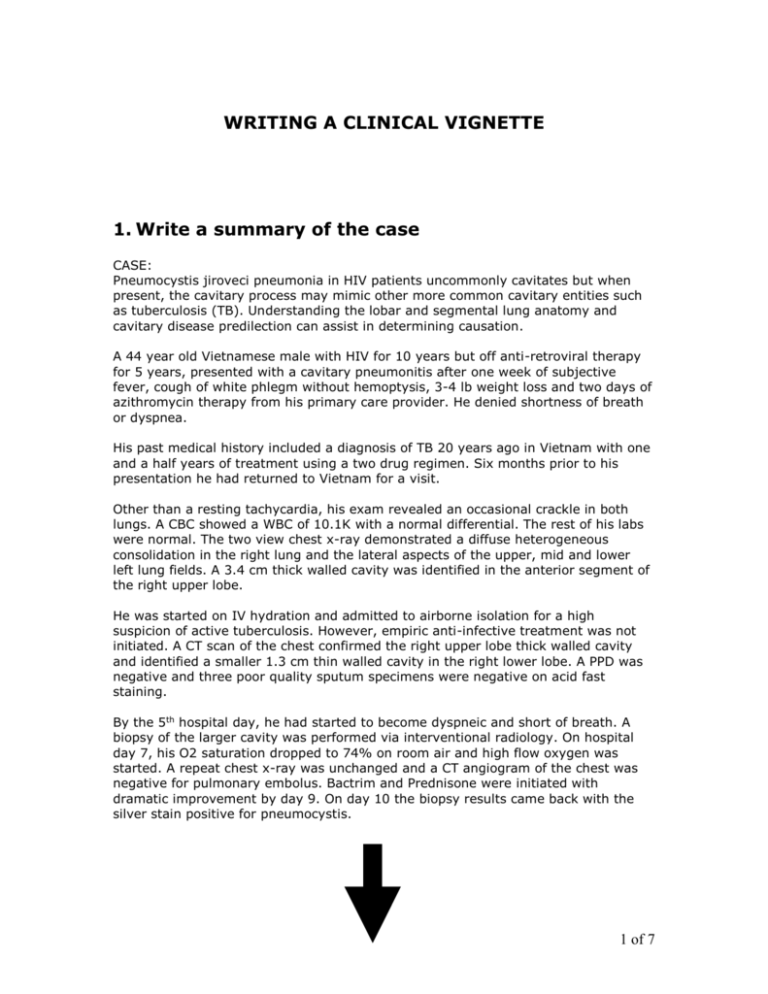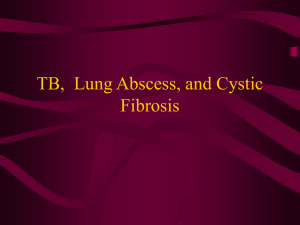WRITING A CLINICAL VIGNETTE Write a summary of the case
advertisement

WRITING A CLINICAL VIGNETTE 1. Write a summary of the case CASE: Pneumocystis jiroveci pneumonia in HIV patients uncommonly cavitates but when present, the cavitary process may mimic other more common cavitary entities such as tuberculosis (TB). Understanding the lobar and segmental lung anatomy and cavitary disease predilection can assist in determining causation. A 44 year old Vietnamese male with HIV for 10 years but off anti-retroviral therapy for 5 years, presented with a cavitary pneumonitis after one week of subjective fever, cough of white phlegm without hemoptysis, 3-4 lb weight loss and two days of azithromycin therapy from his primary care provider. He denied shortness of breath or dyspnea. His past medical history included a diagnosis of TB 20 years ago in Vietnam with one and a half years of treatment using a two drug regimen. Six months prior to his presentation he had returned to Vietnam for a visit. Other than a resting tachycardia, his exam revealed an occasional crackle in both lungs. A CBC showed a WBC of 10.1K with a normal differential. The rest of his labs were normal. The two view chest x-ray demonstrated a diffuse heterogeneous consolidation in the right lung and the lateral aspects of the upper, mid and lower left lung fields. A 3.4 cm thick walled cavity was identified in the anterior segment of the right upper lobe. He was started on IV hydration and admitted to airborne isolation for a high suspicion of active tuberculosis. However, empiric anti-infective treatment was not initiated. A CT scan of the chest confirmed the right upper lobe thick walled cavity and identified a smaller 1.3 cm thin walled cavity in the right lower lobe. A PPD was negative and three poor quality sputum specimens were negative on acid fast staining. By the 5th hospital day, he had started to become dyspneic and short of breath. A biopsy of the larger cavity was performed via interventional radiology. On hospital day 7, his O2 saturation dropped to 74% on room air and high flow oxygen was started. A repeat chest x-ray was unchanged and a CT angiogram of the chest was negative for pulmonary embolus. Bactrim and Prednisone were initiated with dramatic improvement by day 9. On day 10 the biopsy results came back with the silver stain positive for pneumocystis. 1 of 7 2. Add a discussion to the summary CASE: Pneumocystis jiroveci pneumonia in HIV patients uncommonly cavitates but when present, the cavitary process may mimic other more common cavitary entities such as tuberculosis (TB). Understanding the lobar and segmental lung anatomy and cavitary disease predilection can assist in determining causation. A 44 year old Vietnamese male with HIV for 10 years but off anti-retroviral therapy for 5 years, presented with a cavitary pneumonitis after one week of subjective fever, cough of white phlegm without hemoptysis, 3-4 lb weight loss and two days of azithromycin therapy from his primary care provider. He denied shortness of breath or dyspnea. His past medical history included a diagnosis of TB 20 years ago in Vietnam with one and a half years of treatment using a two drug regimen. Six months prior to his presentation he had returned to Vietnam for a visit. Other than a resting tachycardia, his exam revealed an occasional crackle in both lungs. A CBC showed a WBC of 10.1K with a normal differential. The rest of his labs were normal. The two view chest x-ray demonstrated a diffuse heterogeneous consolidation in the right lung and the lateral aspects of the upper, mid and lower left lung fields. A 3.4 cm thick walled cavity was identified in the anterior segment of the right upper lobe. He was started on IV hydration and admitted to airborne isolation for a high suspicion of active tuberculosis. However, empiric anti-infective treatment was not initiated. A CT scan of the chest confirmed the right upper lobe thick walled cavity and identified a smaller 1.3 cm thin walled cavity in the right lower lobe. A PPD was negative and three poor quality sputum specimens were negative on acid fast staining. By the 5th hospital day, he had started to become dyspneic and short of breath. A biopsy of the larger cavity was performed via interventional radiology. On hospital day 7, his O2 saturation dropped to 74% on room air and high flow oxygen was started. A repeat chest x-ray was unchanged and a CT angiogram of the chest was negative for pulmonary embolus. Bactrim and Prednisone were initiated with dramatic improvement by day 9. On day 10 the biopsy results came back with the silver stain positive for pneumocystis. DISCUSSION: This case illustrates several points. Although very uncommon (2-7 % of cases in HIV patients), Pneumocystis can cavitate with either thick-walled or thin-walled cavities. Knowing lung segment anatomy and its relationship on chest x-ray and chest CT scans allows for more specific localization of a cavity. The segmental location of a 2 of 7 lung cavity can be helpful in formulating a differential diagnosis and initiating appropriate empiric treatment. In this case, the admitting team prioritized TB to the top of the differential list and decided not to initiate other empiric anti-infective therapy while waiting for confirmation of TB even though the patient showed clinical progression. However, tubercular cavities preferentially arise in the upper lobe apical and posterior segments with sparing of the anterior segment. The superior segment of the lower lobe is also a preferential location. As in this case, the finding of a cavity in the anterior segment of the upper lobe dramatically reduces the likelihood of tuberculosis, so much so that other etiologies should be considered first. 3. Add a few pertinent references CASE: Pneumocystis jiroveci pneumonia in HIV patients uncommonly cavitates but when present, the cavitary process may mimic other more common cavitary entities such as tuberculosis (TB). Understanding the lobar and segmental lung anatomy and cavitary disease predilection can assist in determining causation. A 44 year old Vietnamese male with HIV for 10 years but off anti-retroviral therapy for 5 years, presented with a cavitary pneumonitis after one week of subjective fever, cough of white phlegm without hemoptysis, 3-4 lb weight loss and two days of azithromycin therapy from his primary care provider. He denied shortness of breath or dyspnea. His past medical history included a diagnosis of TB 20 years ago in Vietnam with one and a half years of treatment using a two drug regimen. Six months prior to his presentation he had returned to Vietnam for a visit. Other than a resting tachycardia, his exam revealed an occasional crackle in both lungs. A CBC showed a WBC of 10.1K with a normal differential. The rest of his labs were normal. The two view chest x-ray demonstrated a diffuse heterogeneous consolidation in the right lung and the lateral aspects of the upper, mid and lower left lung fields. A 3.4 cm thick walled cavity was identified in the anterior segment of the right upper lobe. 3 of 7 He was started on IV hydration and admitted to airborne isolation for a high suspicion of active tuberculosis. However, empiric anti-infective treatment was not initiated. A CT scan of the chest confirmed the right upper lobe thick walled cavity and identified a smaller 1.3 cm thin walled cavity in the right lower lobe. A PPD was negative and three poor quality sputum specimens were negative on acid fast staining. By the 5th hospital day, he had started to become dyspneic and short of breath. A biopsy of the larger cavity was performed via interventional radiology. On hospital day 7, his O2 saturation dropped to 74% on room air and high flow oxygen was started. A repeat chest x-ray was unchanged and a CT angiogram of the chest was negative for pulmonary embolus. Bactrim and Prednisone were initiated with dramatic improvement by day 9. On day 10 the biopsy results came back with the silver stain positive for pneumocystis. DISCUSSION: This case illustrates several points. Although very uncommon (2-7 % of cases in HIV patients), Pneumocystis can cavitate with either thick-walled or thin-walled cavities. Knowing lung segment anatomy and its relationship on chest x-ray and chest CT scans allows for more specific localization of a cavity. The segmental location of a lung cavity can be helpful in formulating a differential diagnosis and initiating appropriate empiric treatment. In this case, the admitting team prioritized TB to the top of the differential list and decided not to initiate other empiric anti-infective therapy while waiting for confirmation of TB even though the patient showed clinical progression. However, tubercular cavities preferentially arise in the upper lobe apical and posterior segments with sparing of the anterior segment. The superior segment of the lower lobe is also a preferential location. As in this case, the finding of a cavity in the anterior segment of the upper lobe dramatically reduces the likelihood of tuberculosis, so much so that other etiologies should be considered first. REFERENCES 1. Gallant JE, Ko AH. 1996. Cavitary Pulmonary Lesions in Patients with Human Immunodeficiency Virus. Clin Inf Dis. 22:671-682. 2. Aviram G, Fishman JE, Sagar M. 2001. Cavitary Lung Disease in AIDS: Etiologies and Correlation with Immune Status. AIDS Patient Care and STDs. 15(7):353361. 3. Ryu JH, Swensen SJ. 2003. Cystic and Cavitary Lung Diseases: Focal and Diffuse. Mayo Clin Proc. 78:744-752. 4. Van Dyck P, Vanhoenacker FM, Van den Brande P, De Schepper AM. 2003. Imaging of Pulmonary Tuberculosis. Eur Radiol. 13:1771-1785. 5. Gadkowski LB, Stout JE. 2008. Cavitary Pulmonary Disease. Clin Micro Rev. 21(2):306-333. 4 of 7 4. Reduce the case summary and discussion to 400 words Pneumocystis jiroveci pneumonia in HIV patients uncommonly cavitates but when present, the cavitary process may mimic other more common cavitary entities such as tuberculosis. Understanding the lobar and segmental lung anatomy and cavitary disease predilection can assist in determining causation. A 44 year old Vietnamese male with HIV presented with a cavitary pneumonitis after one week of subjective fever, nonproductive cough, 3-4 lb weight loss and two days of azithromycin therapy from his primary care provider. He denied shortness of breath or dyspnea. His past medical history included a diagnosis of tuberculosis 20 years ago in Vietnam treated using a two drug regimen for 1 ½ years. Six months prior to his presentation he had returned to Vietnam for a visit. Other than a resting tachycardia, his exam revealed an occasional crackle in both lungs. A CBC showed a WBC of 10.1K with a normal differential. The rest of his labs were normal. The two view chest x-ray demonstrated a diffuse heterogenous consolidation in the right lung and the lateral aspects of the upper, mid and lower left lung fields. A 3.4 cm thick walled cavity was identified in the anterior segment of the right upper lobe. He was started on IV hydration and admitted to airborne isolation for a high suspicion of active tuberculosis. However, empiric anti-infective treatment was not initiated. A CT scan of the chest confirmed the right upper lobe thick walled cavity and identified a smaller 1.3 cm thin walled cavity in the right lower lobe. A PPD was negative and three poor quality sputum specimens were negative on acid fast staining. By the 5th hospital day, he had started to become dyspneic and short of breath. A biopsy of the larger cavity was performed via interventional radiology. On hospital day 7, his O2 saturation dropped to 74% on room air and high flow oxygen was started. A repeat chest x-ray was unchanged and a CT angiogram of the chest was negative for pulmonary embolus. Bactrim and Prednisone were initiated with dramatic improvement by day 9. On day 10 the biopsy results came back with the silver stain positive for pneumocystis. 5 of 7 This case illustrates the importance of lung cavity location. Tubercular cavities preferentially arise in the apical and posterior segments of the upper lobe and the superior segment of the lower lobe. Finding a cavity in the anterior segment of the upper lobe dramatically reduces the likelihood of tuberculosis, and should prompt clinicians to suspect other etiologies. REFERENCES 6. Gallant JE, Ko AH. 1996. Cavitary Pulmonary Lesions in Patients with Human Immunodeficiency Virus. Clin Inf Dis. 22:671-682. 7. Aviram G, Fishman JE, Sagar M. 2001. Cavitary Lung Disease in AIDS: Etiologies and Correlation with Immune Status. AIDS Patient Care and STDs. 15(7):353361. 8. Ryu JH, Swensen SJ. 2003. Cystic and Cavitary Lung Diseases: Focal and Diffuse. Mayo Clin Proc. 78:744-752. 9. Van Dyck P, Vanhoenacker FM, Van den Brande P, De Schepper AM. 2003. Imaging of Pulmonary Tuberculosis. Eur Radiol. 13:1771-1785. 10. Gadkowski LB, Stout JE. 2008. Cavitary Pulmonary Disease. Clin Micro Rev. 21(2):306-333. 5. Add a catchy title UPPER LOBE LUNG CAVITIES – IS TB ALWAYS FIRST IN THE DIFFERENTIAL? Pneumocystis jiroveci pneumonia in HIV patients uncommonly cavitates but when present, the cavitary process may mimic other more common cavitary entities such as tuberculosis. Understanding the lobar and segmental lung anatomy and cavitary disease predilection can assist in determining causation. A 44 year old Vietnamese male with HIV presented with a cavitary pneumonitis after one week of subjective fever, nonproductive cough, 3-4 lb weight loss and two days of azithromycin therapy from his primary care provider. He denied shortness of breath or dyspnea. His past medical history included a diagnosis of tuberculosis 20 years ago in Vietnam treated using a two drug regimen for 1 ½ years. Six months prior to his presentation he had returned to Vietnam for a visit. 6 of 7 Other than a resting tachycardia, his exam revealed an occasional crackle in both lungs. A CBC showed a WBC of 10.1K with a normal differential. The rest of his labs were normal. The two view chest x-ray demonstrated a diffuse heterogenous consolidation in the right lung and the lateral aspects of the upper, mid and lower left lung fields. A 3.4 cm thick walled cavity was identified in the anterior segment of the right upper lobe. He was started on IV hydration and admitted to airborne isolation for a high suspicion of active tuberculosis. However, empiric anti-infective treatment was not initiated. A CT scan of the chest confirmed the right upper lobe thick walled cavity and identified a smaller 1.3 cm thin walled cavity in the right lower lobe. A PPD was negative and three poor quality sputum specimens were negative on acid fast staining. By the 5th hospital day, he had started to become dyspneic and short of breath. A biopsy of the larger cavity was performed via interventional radiology. On hospital day 7, his O2 saturation dropped to 74% on room air and high flow oxygen was started. A repeat chest x-ray was unchanged and a CT angiogram of the chest was negative for pulmonary embolus. Bactrim and Prednisone were initiated with dramatic improvement by day 9. On day 10 the biopsy results came back with the silver stain positive for pneumocystis. This case illustrates the importance of lung cavity location. Tubercular cavities preferentially arise in the apical and posterior segments of the upper lobe and the superior segment of the lower lobe. Finding a cavity in the anterior segment of the upper lobe dramatically reduces the likelihood of tuberculosis, and should prompt clinicians to suspect other etiologies. REFERENCES 11. Gallant JE, Ko AH. 1996. Cavitary Pulmonary Lesions in Patients with Human Immunodeficiency Virus. Clin Inf Dis. 22:671-682. 12. Aviram G, Fishman JE, Sagar M. 2001. Cavitary Lung Disease in AIDS: Etiologies and Correlation with Immune Status. AIDS Patient Care and STDs. 15(7):353361. 13. Ryu JH, Swensen SJ. 2003. Cystic and Cavitary Lung Diseases: Focal and Diffuse. Mayo Clin Proc. 78:744-752. 14. Van Dyck P, Vanhoenacker FM, Van den Brande P, De Schepper AM. 2003. Imaging of Pulmonary Tuberculosis. Eur Radiol. 13:1771-1785. 15. Gadkowski LB, Stout JE. 2008. Cavitary Pulmonary Disease. Clin Micro Rev. 21(2):306-333. 7 of 7







